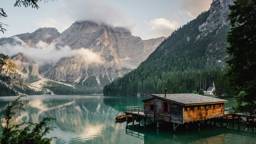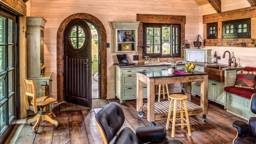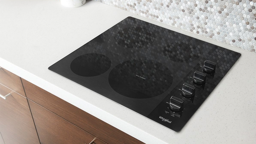
Cabin dreaming is fun, but deciding where a cabin should go can be the most important and challenging part of the building process. That’s because each parcel of land has its own character and personality. Which is why, presumably, you chose yours. But even if it was love at first “site,” don’t rush into construction. “Spend as much time on the property as you can,” advises Robert Knight, AIA, Maine architect and author of “A House on the Water: Inspiration for Living at the Water’s Edge.” His recommendation? “Camp out. After awhile, you’re going to know where the house should be.”
Knight is currently drawing plans for a couple who did just that – for five years. Last winter, they found a spot that was warmer than the rest of the property. Turns out it was open, more elevated, and sheltered from wind – ideal conditions for a cabin. Of course, you don’t have to wait five years. Sometimes, there really is only one spot to build. Or maybe you’re remodeling an existing retreat. Just consider this: A well-sited cabin not only graces the land, it takes full advantage of the setting to keep you cozy. So take the time you need to get to know your land.
The Lay of the Land
Yes, the views are tantalizing. But lower your eyes and focus on the ground around you. Some initial questions you can contemplate:
- Is it hilly or flat? A level area is easier (and cheaper) to build on. A gentle rise usually offers good views and a gravity-friendly site for a septic drain field. Steep slopes are more likely to erode, and construction costs can skyrocket.
- Are there rocky outcrops? You can blast through rock to build the foundation, but it takes money and time. Building around boulders preserves the site’s character.
- Dips or gullies? Low-lying areas are often the coldest and wettest on a site; building here may result in a wet basement, rotting sills or problems with a septic system.
- Is there surface water? If so, is it year-round or seasonal? Steer clear of flood plains. The water table will be too high to install a septic system, not to mention your Shangri-la will be periodically knee deep in water.
- What’s the soil like? Cabins and septic systems need good support and drainage. Building restrictions may apply in areas where clay blocks water from seeping through, or in sandy areas at risk of erosion.
- What about access? How far from the road do you want to be? You may have to weigh privacy against digging out in winter.
- If the property is steep, will the driveway approach from above or below?
- Can the garage shield the cabin from the elements? Where will guests park, and will a path lead them to the main entry? When planning driveways and walkways, remember that curves look more natural than straight lines.
- Where will power lines go? Meet with utility companies on-site to determine the best placement for power lines.
- What makes the property special? Every cabin-worthy lot has special features worth preserving and celebrating, whether it’s a mighty oak, a sunset over a lake or meadow songbirds. You’ll want to site interior and outdoor rooms so you can enjoy these sights and sounds. But if “capturing” a view from one favorite spot means disrupting the landscape, consider other vantage points.
“Work with the topography of the site,” says architect Tom Lenchek, AIA, of Balance Associates in Seattle. For example, building below the brow of a hill instead of on top of the ridge makes a cabin look more incorporated, Lenchek notes. It also preserves the landform. And the less bulldozing involved, the less you spend as well. Let the slope determine the level of first-floor rooms. Or create a compound with separate sleeping cabins eased between boulders or trees.
Sun, Wind, Snow
How you orient the cabin to sun and wind can go a long way toward increased comfort and energy efficiency. Siting with an eye to passive heating and cooling will also make your second home more economical. Visit the property at different times of day, and in different seasons, to track the sun’s passage. In the South, blocking the sun’s heat and glare is important. But in most parts of the country, a southern exposure is ideal, so the majority of windows are designed into the south side of the cabin. Site the cabin leeward of prevailing winds, but open to summer breezes. An exterior space such as a courtyard can create a sunny, wind-free space. Snow may also have an impact on siting. If possible, place paths and driveways where gusts will blow away snow. A north-facing deck or driveway gets less direct sunlight in winter and hence ices up more quickly. In regions with large accumulations, take note of where snow will drop off the roof. “We have the insulation technology to make any cabin shrug off cold winter winds,” says Knight. “But if the form and the siting don’t suggest that it is doing this, the cabin, while physically warm and secure, won’t look comfortable on its site.”
Keeping the Trees
Keep the site green. “Clear-cutting is never a good idea,” says architect Nils Luderowski, AIA, of Saranac Lake, N.Y. "It changes and limits drainage patterns, the efficacy of leach [septic] fields, and may place sediment in the lake.” Retain existing trees and shrubs to screen neighboring cabins, reduce noise and provide cover for wildlife. Conifers on the north side of the cabin make good windbreaks, but ones to the southwest may cast too much shade in winter. Using local materials can create a seamless transition from outside to inside, and make a cabin look and feel natural. Consider the scale, shape and style of neighboring cabins. The last thing you want, says Knight, is for locals to brand your cabin forever as “that new place down the road.”
Site Insight
Understanding your site’s assets and drawbacks is crucial, says Tom Lenchek, AIA, of Balance Associates in Seattle, Wash. So do the legwork, be observant and take photos. Lenchek’s firm employs QuickTime VR (Virtual Reality) software for a 360-degree perspective of the site. A built-in compass “allows us to quantify the site in a graphic way,” he says. Wisconsin Log Homes utilizes SoftPlan, a three-dimensional software, to let clients virtually tour the cabin before the first footing is poured. “We actually create a plot map of the homeowner’s property and rotate the floor plan outline to be sure we are capturing the best views, while taking into account the direction of the sun, wind, and surrounding neighbors,” says WLH designer Brian Delwiche.Additional ResearchNot all site drawbacks can be seen. Ask your local planning department about:
-
Zoning ordinances that regulate land usage.
-
Easements on your land that prohibit building in that area.
-
Setbacks (minimum allowable distances) from the cabin to the property lines or shoreline.
-
Restrictive covenants regulating cabin size.
-
Future construction that may block views.
Sources:
- Robert Knight, Maine architect and author, www.knightassociates.com
- Tom Lenchek, architect, Balance Associates, Seattle, Wash., www.balanceassociates.com
- Nils Luderowski, architect, Saranac Lake, N.Y., www.luderowskiarchitect.com










